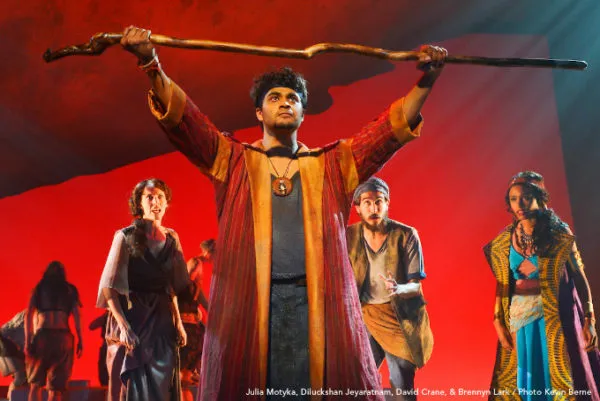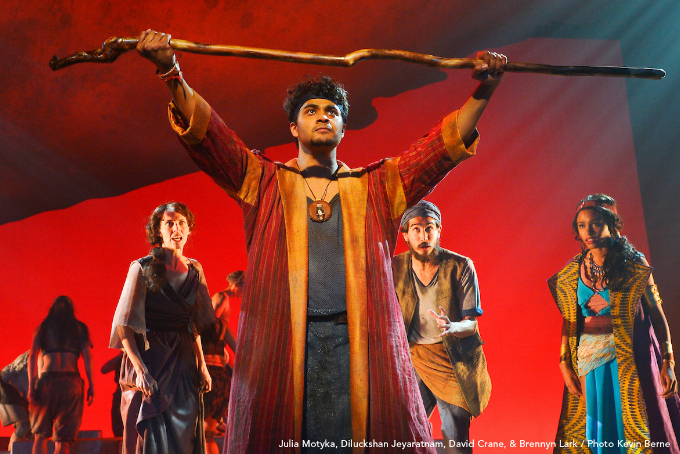
Watching Theatreworks’ “The Prince of Egypt” has again led me to think about orientalism in theater — yes, a concept, made iconic by Edward Said in 1978, that students will undoubtedly and grudgingly stumble into at least once during their time at Stanford. The original “The Prince of Egypt” film released by DreamWorks in 1998 has become somewhat of a classic, if not somewhat of an underground animated film; its score was written by Hans Zimmer with songs by Stephen Schwartz. While the musical numbers themselves aren’t particularly memorable (in part overshadowed by films like “The Lion King,” which was released in 1994), it’s worth noting that effort was put into creating an emblematic and a respectfully tribute to the cultural identity of Egypt and the area. Nevertheless, the music and visuals of an artwork — film, musical or otherwise — raises the question: when does inspiration become appropriation?
“The Prince of Egypt” tells the story of Moses (Diluckshan Jeyaratnam) and Ramses (Jason Gotay), two princes of Egypt — and from here, it’s probably obvious. Moses quickly discovers that he is in fact not an Egyptian and instead receives a message from God asking him to save his people from slavery. Jeyaratnam, a Tamil artist, played a huge figurehead of the Abrahamic religions, and I didn’t know what to think about the cultural implications, let alone representation of an ethnic and religious minority, within context. With strong vocal performances from Jeyaratnam and Gotay, I was swept away by the majestic feel of the score but constantly felt weighted down by this — I commend the production for featuring an individual of color as Moses (and a cast that heavily features performers of color), but I couldn’t help but feel uncomfortable.
This reminds me of the casting of Telly Leung in the role of Disney’s “Aladdin” on Broadway — while it’s great to see an individual of color playing characters who are not white, it raises questions about the ethics and overall representational value (whether harmful or otherwise) of people of color playing other people of color. (Then again, the world of “Aladdin” is ultimately a complex, rather exoticized amalgam of many locations and cultures that have been orientalized, so it’s really tough to say anything conclusive about this.)
While I would like to jump to applauding the audacity of the choreography by Sean Cheesman and visually dazzling movement work performed by the cast, certain dance numbers seemed to be inspired by styles such as bhangra, which didn’t feel intentionally exploitative, but more so misleading for a predominantly white audience. Nevertheless, the movement-based group numbers of “The Prince of Egypt” was artistically bold, including the portrayal of God using a large quantity of people, contributed a magical, otherworldly feel to the production. Similarly colorful lighting of reds, orange and browns in the color palette coupled with a minimalistic modular set comprised of blocks set the feel of an alternate time and place.
Narrative-wise, this world premiere theatrical adaptation of the original film and story felt broad enough to support the interests of a wide range of audience members, but identifiable enough to also stand as an independent story. The story of Moses parting the Red Sea, even for those unreligious, is a narrative that many know, even if some don’t know the context. In this manner, “The Prince of Egypt” also serves as an exploration of sibling dynamics and power struggles relevant to families and communities today. While not actively sociopolitically relevant and still considering the struggles in representation that the production may have, “The Prince of Egypt” provides a theatrically stunning take on an iconic story and film that individuals of all ages will love.
Note: a previous version of this article incorrectly stated that Telly Leung was cast in the touring production of “Aladdin.” Leung was cast in the Broadway production.
Contact Olivia Popp oliviapopp ‘at’ stanford.edu.
